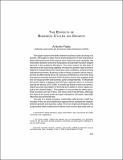Artículo
The effects of business cycles on growth
Date
2002Abstract
This paper explores the links between business cycles and long-run growth. Although it is clear from a theoretical point of view that both of these phenomena are driven by the same macroeconomic variables, the interaction between economic fluctuations and growth has been largely ignored in the academic literature. The main reason for this lack of attention is the surprising stability of long-term growth rates and their apparent independence from business cycle conditions, at least among industrial economies. Business cycles in these countries can be characterized as alternating series of recessions followed by recoveries that bring gross domestic product (GDP) levels to trend, this suggests that one can study growth and business cycles independently. To illustrate this point, figure 1 displays real GDP per capita for the U.S. economy during the period 1870–1999. A simple log-linear trend represents a highly accurate description of the long-term patterns of per capita output in the United States. This pattern is very similar for other industrial countries such as France, Germany, and Great Britain, although the slope of the trend shows stronger indications of breaks, especially after the Second World War.
Collections
View/


